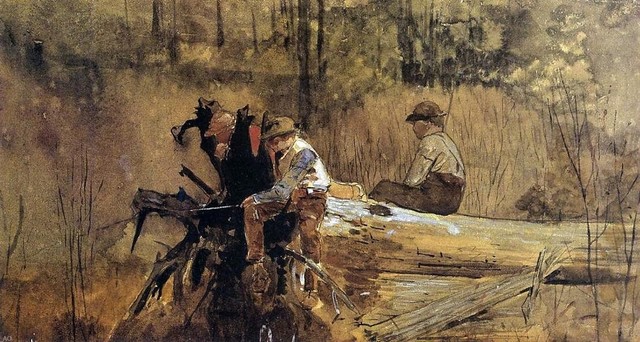Winslow Homer: A Post Civil War Vision of the Adirondacks
After first traveling to the Adirondacks in 1870, Winslow Homer visited the region regularly, and it became the site of many of his most renowned paintings. Homer returned to the Adirondacks at least twenty-one times in the four decades before his death, and like Frederic Remington, he witnessed the rush of tourists and sportsmen to the region following the Civil War; he even spent time participating in recreational activities himself (Tatham xii). As a result, Homer’s paintings reflected the new conceptions of humans’ relationship with the environment. Yet, the post-Civil War era also witnessed growth in the middle class and changes in the roles of women, and such transformations were quite apparent in the Adirondacks. Commenting on novel attitudes towards nature and society, Homer illustrated conceptions of the Adirondacks as not only a place for recreation, but a space for many groups and classes of people to enjoy (Tatham xiv).
The Relationship Between Humans and Nature
One of Homer’s first paintings of the Adirondacks, The Trapper (1870) (right) speaks largely to the growing presence of humans in the Adirondack region. The painting focuses on a man standing on a log on the West Bay of Mink Pond (Tatham 25). Interestingly, Homer eliminates Beaver Mountain from the painting, and by doing so, advances the significance of the man in the painting (Tatham 25). Making the rustic man the focus of the painting, Homer champions and even prompts admiration of the self sufficient woodsman alone in the wilderness, representing the new order and post-war vision in which man and nature are members of the same community (Tatham 29).

Interestingly, Homer offers another existing but drastically different view of the relationship between humans and nature in Two Guides (1877) (right). In comparison to the undisturbed environment painted in The Trapper, the men in Two Guides, each holding axes, stand in an area cleared of trees (Tatham, 72). The guides are also engaged with each other, unlike the trapper who is only focused on the wilderness (Tatham 72). The guides are presumably more interested in the sportsmen they attend to than in nature itself and, as a result, appear less acquainted with the landscape (Tatham 72). Evidently, in The Trapper and Two Guides, Homer denotes two contrasting and existing views of humans and their interactions with the environment: one in which humans and nature exist in a more symbiotic way, and another in which man controls and alters the environment.
The Adirondacks as Public Place
Homer’s paintings also represent the increasing presence of women in the Adirondacks. In Fishing Party (1869) (lower left), Homer shows woman fishing along a lakeside. He also depicts women hiking in In the Mountains (1877) (lower right). In the Mountains is especially unique in how it portrays the Adirondacks as not only a public place, but as a platform for social change. Homer presents the women in this painting as young, affluent, independent, and self-assured. The women are also outside the domestic sphere, and in this way Homer captures the new visions of women that surfaced during the post-war era women’s rights movements (Tatham 66). Evidently, Homer’s artwork recognized views of the Adirondacks as a public place in the widest sense and as a space free of social constraints. Such views are reflected in his paintings of women and children participating in wilderness recreation (Tatham 66).


Fishing Party (1869) In the Mountains (1877)
Works Cited
Mandel, P. C. Fair Wilderness: American Paintings in the Collection of The Adirondack Museum (A. W. Gilborn, Ed.). New York: The Adirondack Museum, 1990. Print.
Tatham, David. Winslow Homer in the Adirondacks. New York: Syracuse University Press. 1996, Print.
Image Sources (in order of appearance)
Banner courtesy of: http://www.portlandmuseum.org/homer/about-winslow-homer
The Trapper courtesy of: http://commons.wikimedia.org/wiki/File:Winslow_Homer_-_An_Adirondack_Lake.jpg
Two Guides courtesy of: https://www.artrenewal.org/pages/artwork.php?artworkid=31512&size=large
Waiting for a Bite courtesy of: http://www.houzz.com/photos/11242844/Winslow-Homer-Waiting-for-a-Bite-Why-Dont-the-Suckers-Bite-Print-traditional-artwork
Fishing Party courtesy of: http://www.brooklynmuseum.org/opencollection/objects/2498/The_Fishing_Party
In the Mountains courtesy of: https://www.brooklynmuseum.org/opencollection/objects/420/In_the_Mountains
